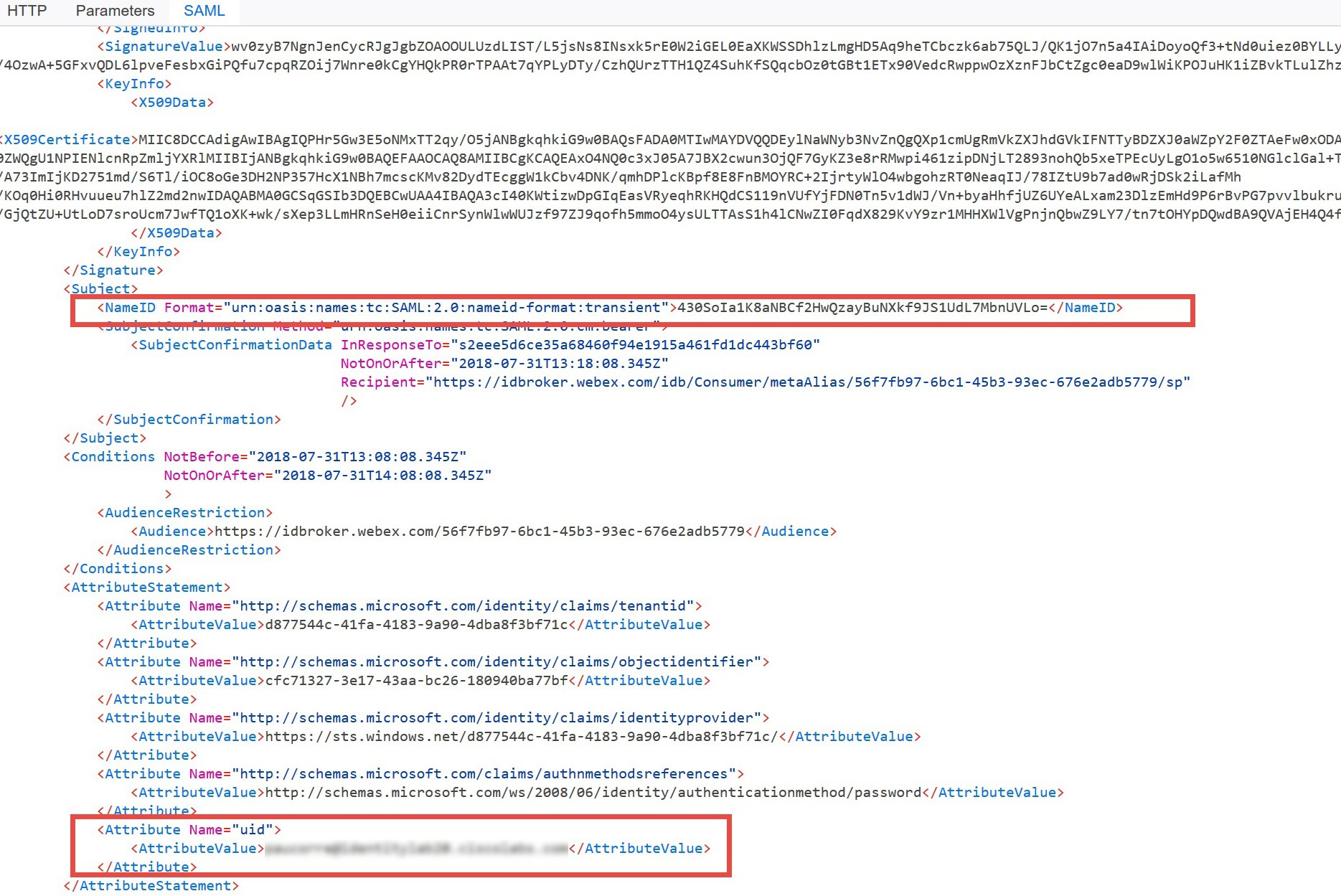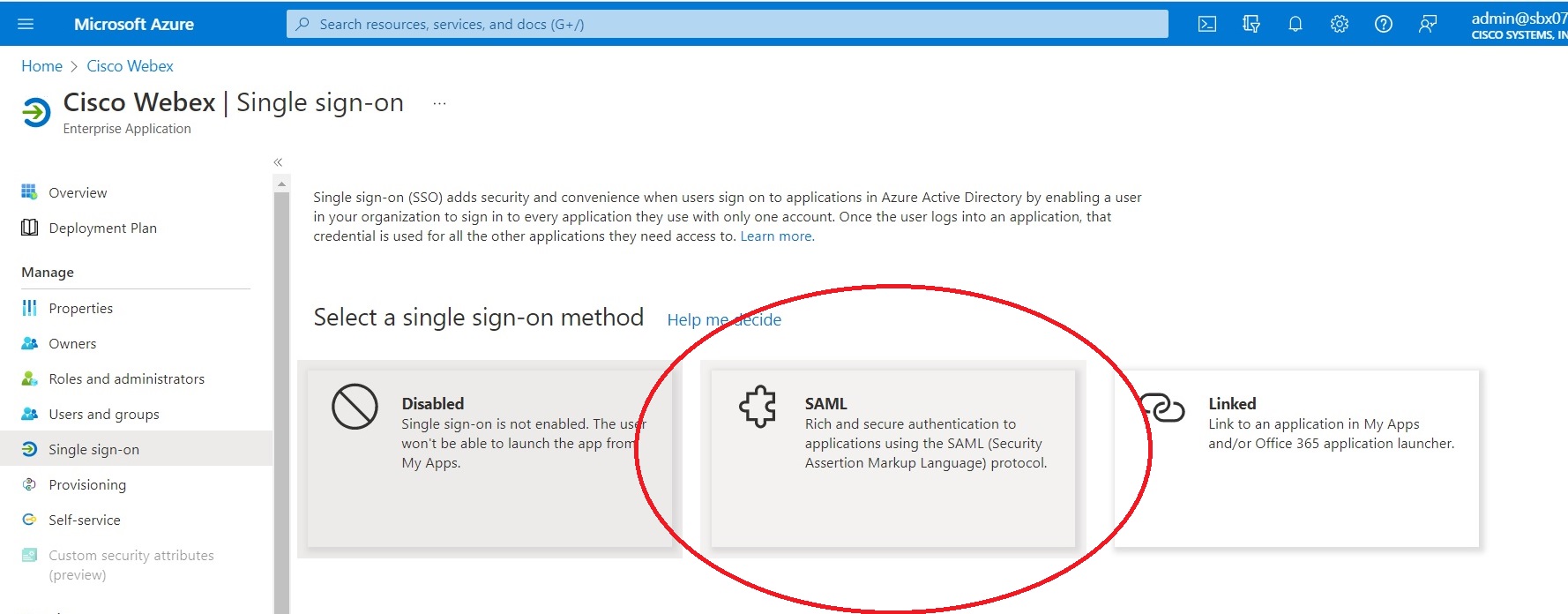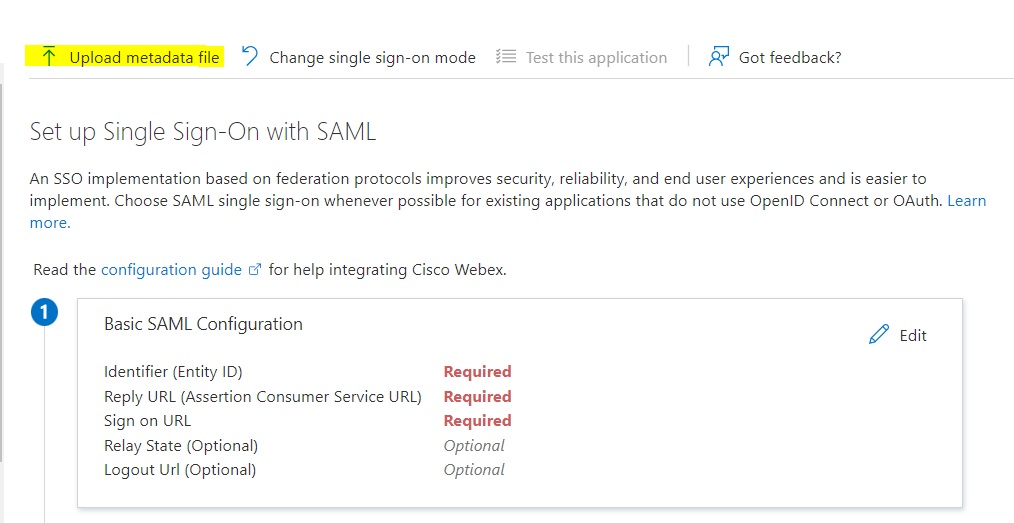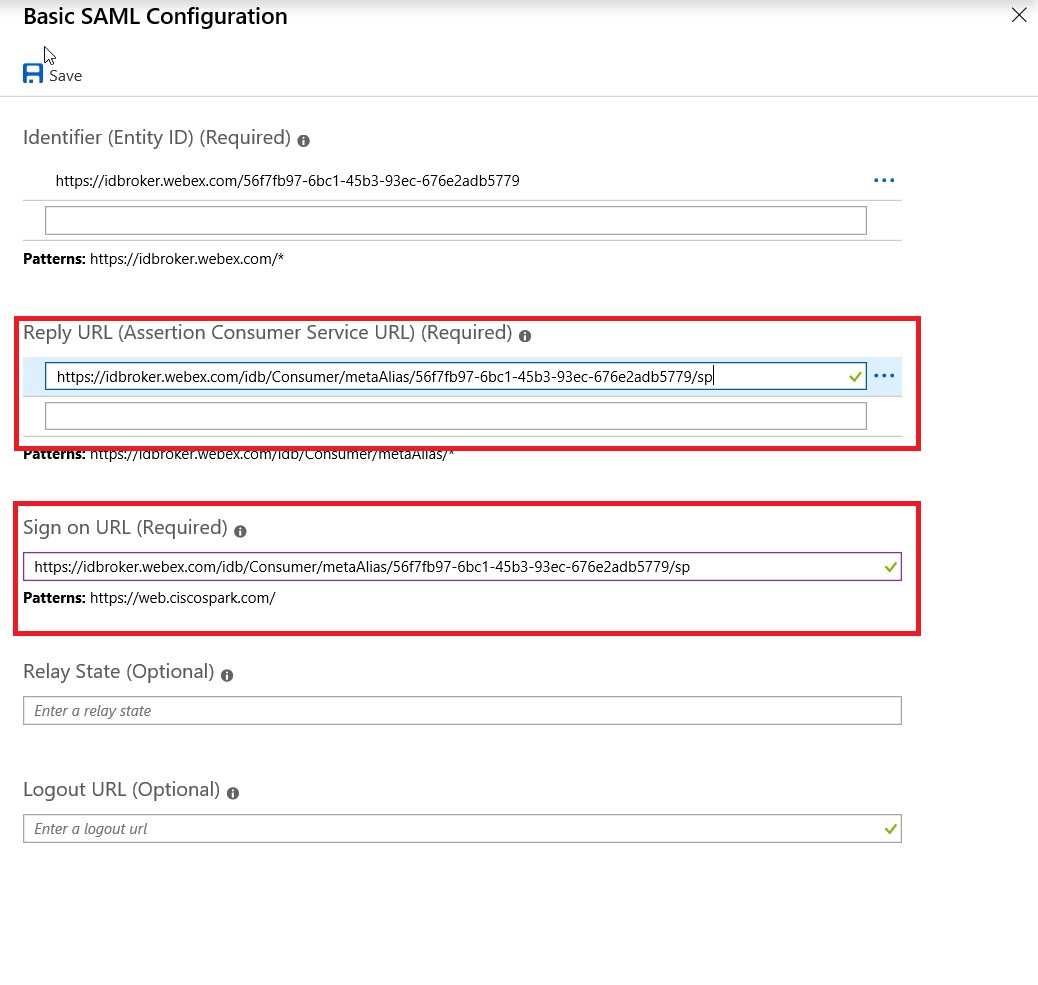- Home
- /
- Article


Configure single sign-on in Control Hub with Microsoft Entra ID
 In this article
In this article Feedback?
Feedback?You can configure a single sign-on (SSO) integration between a Control Hub customer organization and a deployment that uses Microsoft Entra ID as an identity provider (IdP).
Single sign-on and Control Hub
Single sign-on (SSO) is a session or user authentication process that permits a user to provide credentials to access one or more applications. The process authenticates users for all the applications that they are given rights to. It eliminates further prompts when users switch applications during a particular session.
The Security Assertion Markup Language (SAML 2.0) Federation Protocol is used to provide SSO authentication between the Webex cloud and your identity provider (IdP).
Profiles
Webex App only supports the web browser SSO profile. In the web browser SSO profile, Webex App supports the following bindings:
-
SP initiated POST -> POST binding
-
SP initiated REDIRECT -> POST binding
NameID format
The SAML 2.0 Protocol supports several NameID formats for communicating about a specific user. Webex App supports the following NameID formats.
-
urn:oasis:names:tc:SAML:2.0:nameid-format:transient -
urn:oasis:names:tc:SAML:1.1:nameid-format:unspecified -
urn:oasis:names:tc:SAML:1.1:nameid-format:emailAddress
In the metadata that you load from your IdP, the first entry is configured for use in Webex.
Integrate Control Hub with Microsoft Entra ID
Webex supports only one IdP for each authentication request. The authentication flow is as follows: User > Webex authentication > IdP 1 > Webex authentication > User. This means that while different users can authenticate using different IdPs, a user cannot switch between multiple IdPs during a single authentication process. Any additional steps such as MFA must be integrated with the single IdP used for that particular request.
The configuration guides show a specific example for SSO integration but do not provide exhaustive configuration for all possibilities. For example, the integration steps for nameid-format urn:oasis:names:tc:SAML:2.0:nameid-format:transient are documented. Other formats such as urn:oasis:names:tc:SAML:1.1:nameid-format:unspecified or urn:oasis:names:tc:SAML:1.1:nameid-format:emailAddress will work for SSO integration but are outside the scope of our documentation.
Set up this integration for users in your Webex organization (including Webex App, Webex Meetings, and other services administered in Control Hub). If your Webex site is integrated in Control Hub, the Webex site inherits the user management. If you can't access Webex Meetings in this way and it is not managed in Control Hub, you must do a separate integration to enable SSO for Webex Meetings.
Before you begin
For SSO and Control Hub, IdPs must conform to the SAML 2.0 specification. In addition, IdPs must be configured in the following manner:
- In Entra ID, provisioning is only supported in manual mode. This document only covers single sign-on (SSO) integration.
- Existing Webex customers with previous federation configurations may encounter issues with the standard Entra ID Webex template due to changes in SAML attributes. We recommend setting up a custom Entra ID federation to resolve this using your previous SAML settings. Ensure you conduct the Control Hub SSO test to allow compatibility and address any discrepancies.
Download the Webex metadata to your local system
| 1 |
Sign in to Control Hub. |
| 2 |
Go to . |
| 3 |
Go to the Identity provider tab and click Activate SSO. |
| 4 |
Select an IdP. |
| 5 |
Choose the certificate type for your organization:
Trust anchors are public keys that act as an authority to verify a digital signature's certificate. For more information, refer to your IdP documentation. |
| 6 |
Download the metadata file. The Webex metadata filename is idb-meta-<org-ID>-SP.xml. |
Configure SSO application settings in Entra ID
Before you begin
-
See What is Microsoft Entra? to understand the IdP capabilities in Entra ID.
-
Configure Microsoft Entra ID.
-
Create local users or synchronize with an on-premises Entra ID system.
-
Open the Webex metadata file that you downloaded from Control Hub.
-
There is a related tutorial on the Microsoft documentation site.
| 1 |
Sign in to the Microsoft Entra admin center. |
| 2 |
If you cannot see the Microsoft Entra ID icon, click More services. 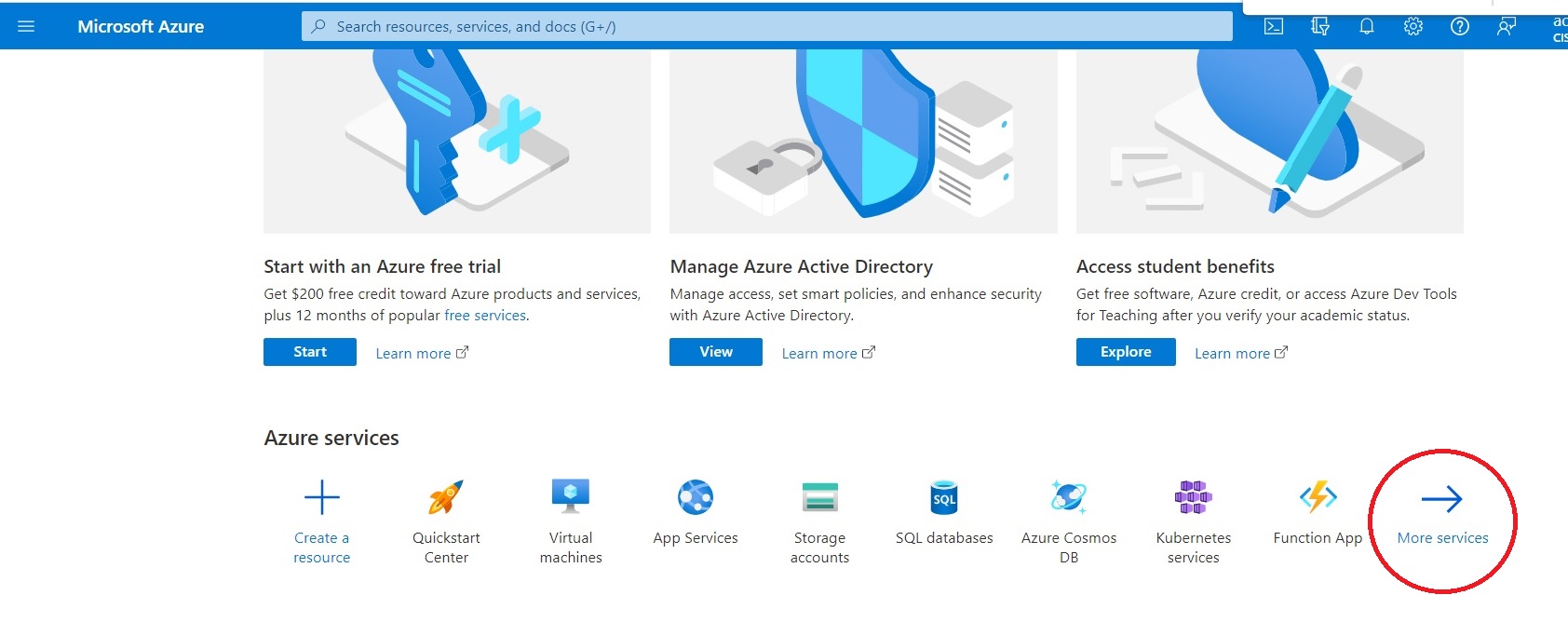
|
| 3 |
Go to Microsoft Entra ID for your organization. 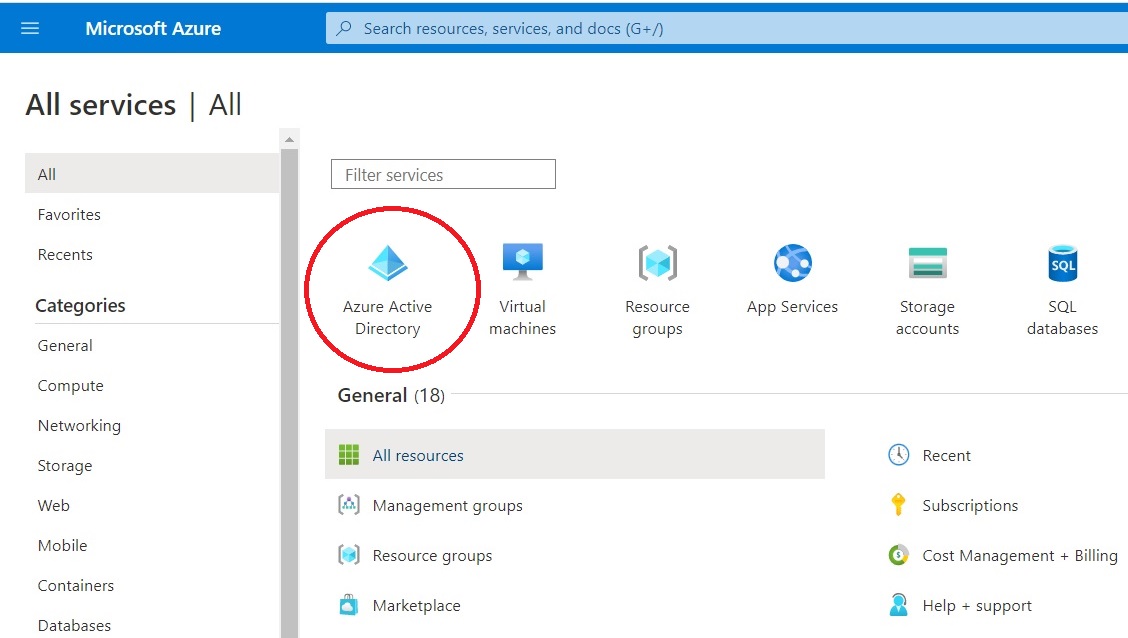
|
| 4 |
Go to Enterprise Applications and then click Add. |
| 5 |
Click Add an application from the gallery. |
| 6 |
In the search box, type Cisco Webex. 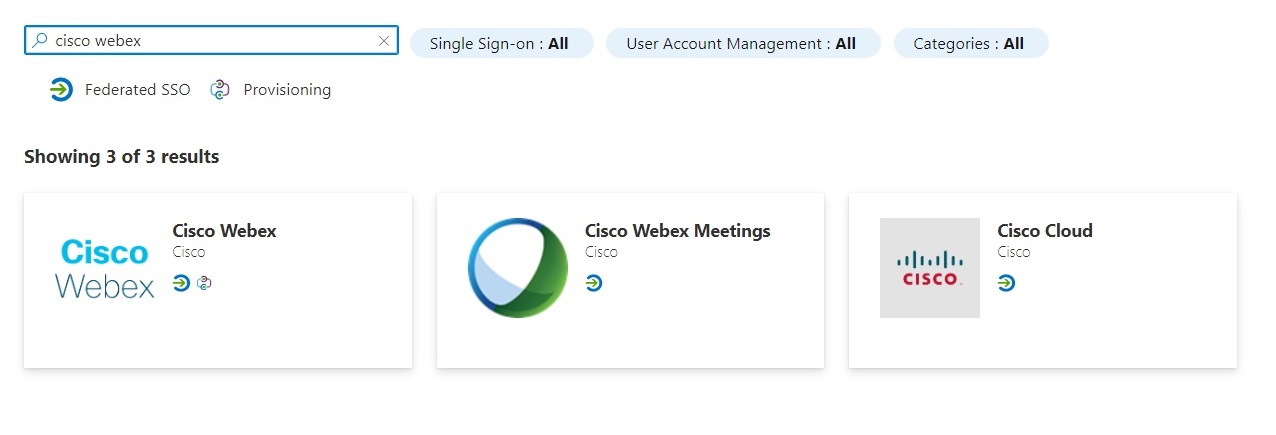
|
| 7 |
In the results pane, select Cisco Webex, and then click Create to add the application. 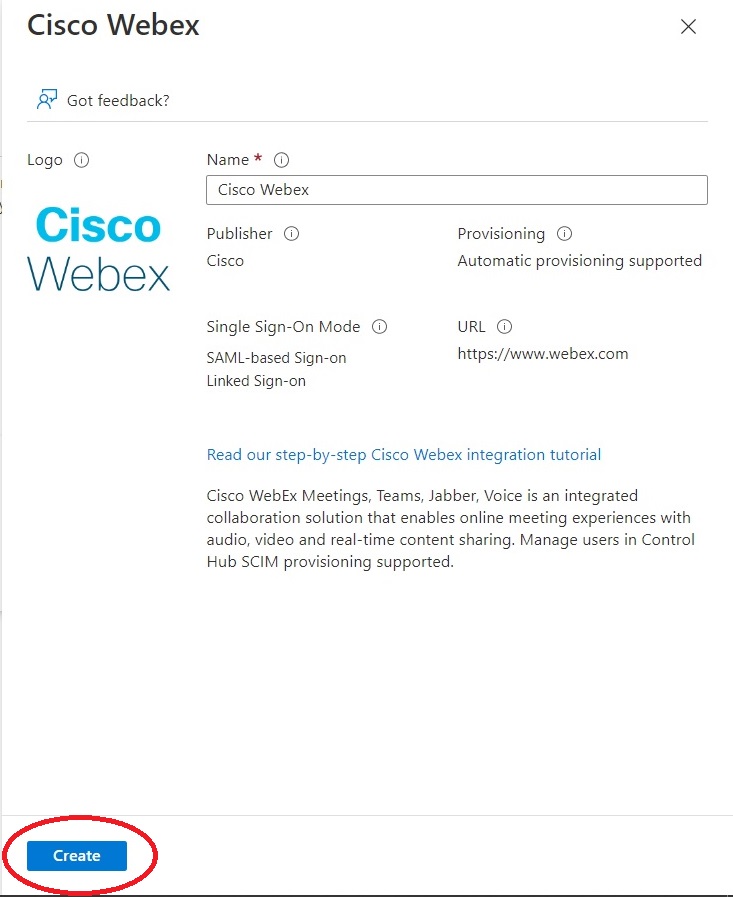
|
| 8 |
To make sure that the Webex application you've added for single sign-on doesn't show up in the user portal, open the new application. Under Manage, click Properties, and set Visible to users? to No. 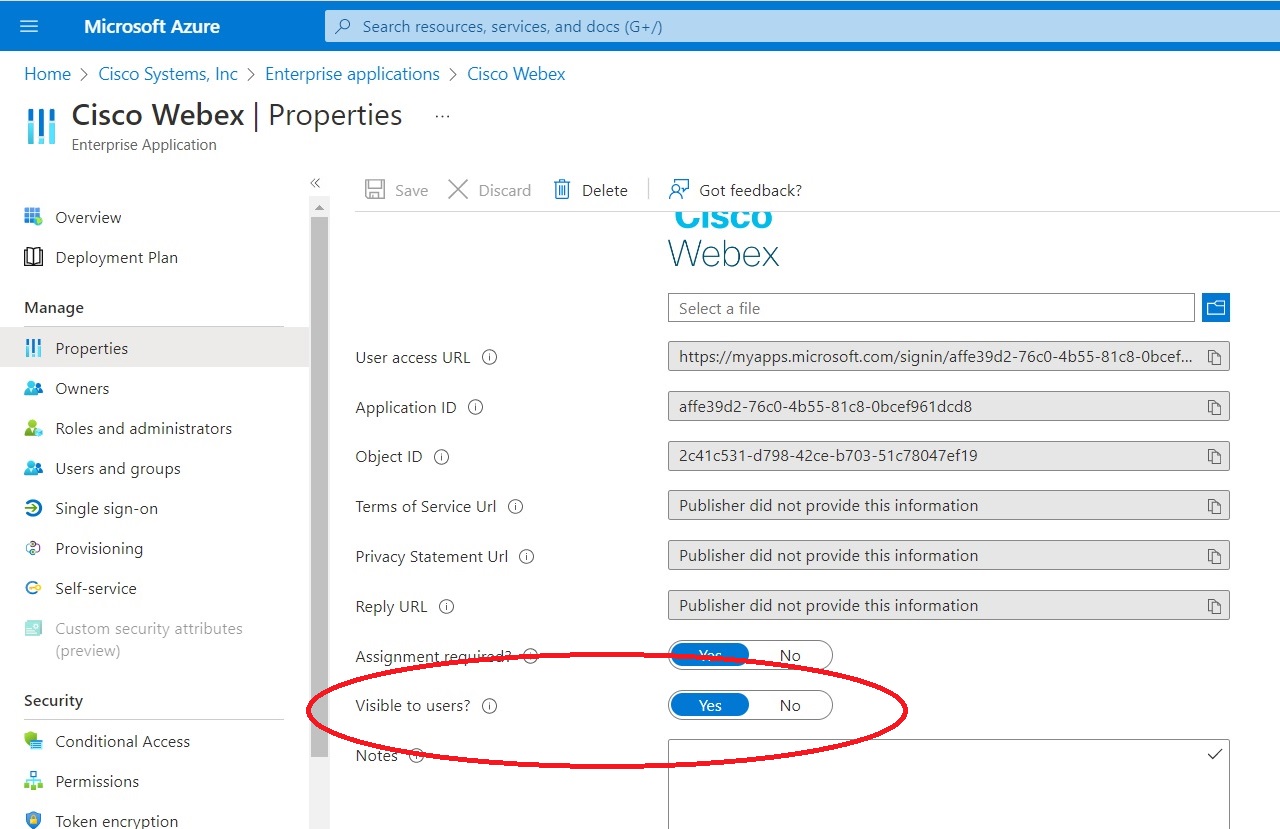
We don't support making Webex App visible to users. |
| 9 |
Configure Single-Sign On: |
| 10 |
Go to Manage > Users and groups, and then choose the applicable users and groups that you want to grant access to Webex App. |
| 11 |
On the Set up Single Sign-On with SAML page, in the SAML Signing Certificate section, click Download to download the Federation Metadata XML and save it on your computer. 
|
Import the IdP metadata and enable single sign-on after a test
After you export the Webex metadata, configure your IdP, and download the IdP metadata to your local system, you are ready to import it into your Webex organization from Control Hub.
Before you begin
Do not test SSO integration from the identity provider (IdP) interface. We only support Service Provider-initiated (SP-initiated) flows, so you must use the Control Hub SSO test for this integration.
| 1 |
Choose one:
|
| 2 |
On the Import IdP metadata page, either drag and drop the IdP metadata file onto the page or use the file browser option to locate and upload the metadata file. Click Next.
You should use the More secure option, if you can. This is only possible if your IdP used a public CA to sign its metadata. In all other cases, you must use the Less secure option. This includes if the metadata is not signed, self-signed, or signed by a private CA. Okta does not sign the metadata, so you must choose Less secure for an Okta SSO integration. |
| 3 |
Select Test SSO setup, and when a new browser tab opens, authenticate with the IdP by signing in. If you receive an authentication error there may be a problem with the credentials. Check the username and password and try again. A Webex App error usually means an issue with the SSO setup. In this case, walk through the steps again, especially the steps where you copy and paste the Control Hub metadata into the IdP setup. To see the SSO sign-in experience directly, you can also click Copy URL to clipboard from this screen and paste it in a private browser window. From there, you can walk through signing in with SSO. This step stops false positives because of an access token that might be in an existing session from you being signed in. |
| 4 |
Return to the Control Hub browser tab.
The SSO configuration does not take effect in your organization unless you choose first radio button and activate SSO. |
What to do next
Use the procedures in Synchronize Okta Users into Cisco Webex Control Hub if you want to do user provisioning out of Okta into the Webex cloud.
Use the procedures in Synchronize Microsoft Entra ID users into Cisco Webex Control Hub if you want to do user provisioning out of Entra ID into the Webex cloud.
You can follow the procedure in Suppress Automated Emails to disable emails that are sent to new Webex App users in your organization. The document also contains best practices for sending out communications to users in your organization.
Troubleshoot Entra ID integration
When doing the SAML test, make sure that you use Mozilla Firefox and you install the SAML tracer from https://addons.mozilla.org/en-US/firefox/addon/saml-tracer/
Check the assertion that comes from Entra ID to make sure that it has the correct nameid format and has an attribute uid that matches a user in Webex App.
